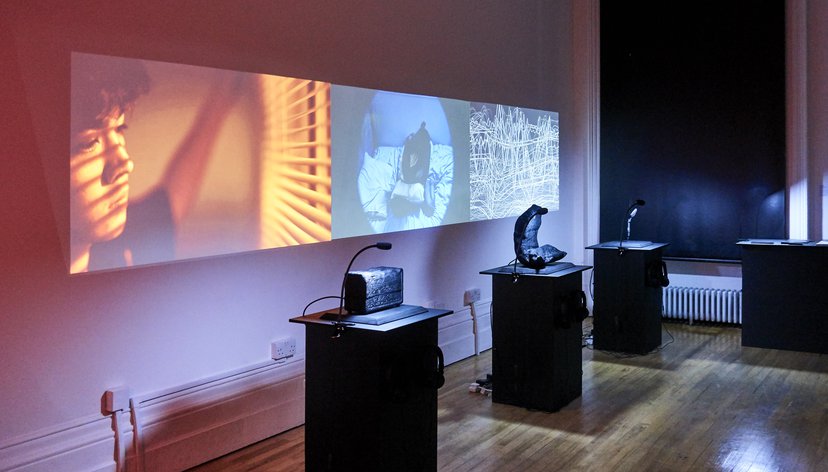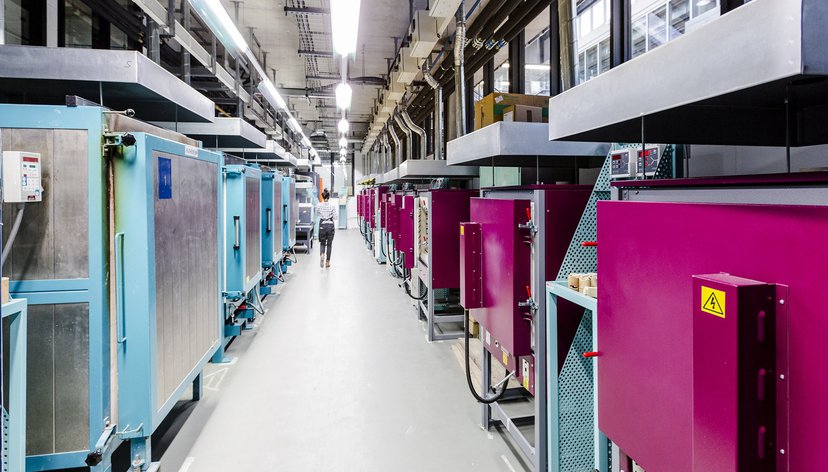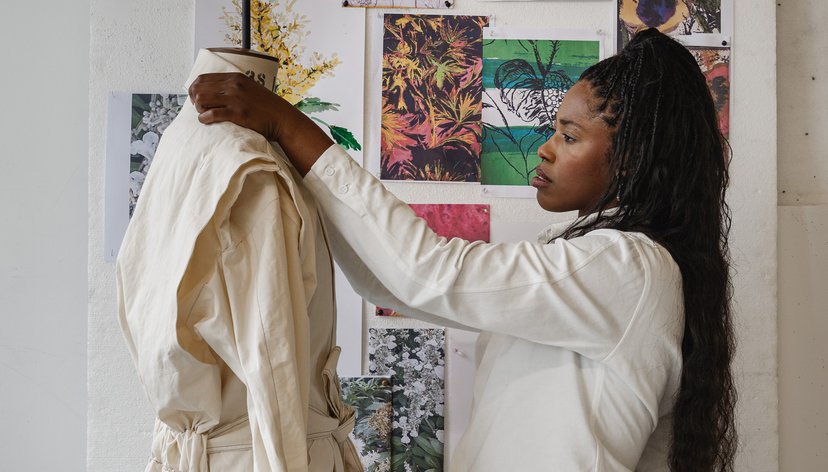History
The Royal College of Art (RCA) was founded in 1837 as the Government School of Design. In 1967 it was granted a Royal Charter and university status. Today, the RCA remains the world’s most influential postgraduate art and design institution.
1837–1929
The RCA was founded in 1837 as the Government School of Design, located in Somerset House in the Strand, London. Following the Great Exhibition of 1851, this small-scale operation was radically transformed to accommodate art as well as design. This led to the institution being rechristened the National Art Training School at its new home in South Kensington. In 1896 it became the Royal College of Art.
In the early days a distinctive version of the Arts and Crafts philosophy was dominant at the RCA. However by the early 1900s that atmosphere changed. The RCA was the birthplace of The New Sculpture movement in Britain and continued to be a major centre of influence in the new century. Students from this time include such luminaries as Barbara Hepworth and Henry Moore.

RCA Sculpture department, 1905
1930–49
Throughout the 1930s and '40s the RCA’s scope and reputation continued to grow. The College placed a new emphasis on teaching product design and providing specialised, professional instruction. New courses were introduced, such as Graphic Design, Industrial Design and Fashion. The consistently high calibre of students included the likes of Robin and Lucienne Day.

RCA students in a drawing class at Loughrigg, from the papers of Shelia Donaldson Walters
1950–79
The 1950s and '60s saw the RCA at the centre of the explosion of Pop Art culture. This generation of students transformed British art and design. Peter Blake, Pauline Boty, David Hockney and R B Kitaj were among its ranks. Meanwhile, the fashion and textiles department was leading its own design revolution with Ossie Clark, Althea McNish and Zandra Rhodes. During this time Ridley and Tony Scott studied film.
The College embraced this period of dramatic social change with changes of its own. In 1962 all design and applied art courses moved to the new Darwin Building in Kensington Gore. Then, in 1967, the College was granted a Royal Charter, endowing it with university status and the power to grant its own degrees.
The 1960s also saw the Industrial Design course become a discipline in its own right. Under the leadership of eminent designer Misha Black, some of the bold new design talent included product design duo, Richard Seymour and Dick Powell. Another new course was Vehicle Design in 1967. Early graduates of which went on to devise cars such as the Audi Quattro (Martin Smith), the Aston Martin DB7 (Ian Callum, former Director of Design at Jaguar) and the Porsche 911 (Tony Hatter).
No department was immune to change. Applied arts such as ceramics and glass began to find a new, contemporary way forward in the 1970s. Students such as Elizabeth Fritsch and Alison Britton established themselves as leading lights. In Silversmithing & Jewellery (as Jewellery & Metal was then known), Eric Spiller and Michael Rowe were doing the same.
The 1960s and ‘70s were also a heady time for the communications department. Its alumni designed some of the period’s most iconic images, including the film poster for A Clockwork Orange (1971) and the now-famous Rolling Stones lips logo. This was an era that also saw Industrial Design student James Dyson develop the idea for the ‘Seatruck’ while studying Interiors.

Paper Pools, David Hockney
1980–99
It was all change during the 1980s and '90s. Sir Christopher Frayling became Rector in 1996 and there was a comprehensive programme of cross-college reconstruction, re-equipment and expansion. This included the growth of Product Design. During this time the programme produced internationally renowned designers such as Jasper Morrison, Tord Boontje and Ross Lovegrove. New facilities encouraged innovative approaches to printmaking and Animation became a department in its own right. Graduates from this new course included Brian Wood, author of the Cramp Twins series, and Alan Smith and Adam Foulkes (directors of Honda’s ‘Hate Something: Change Something’ advertisement).
These decades also saw the establishment of the humanities at the RCA. The College introduced a History of Design programme in 1982, followed by Conservation (run in association with the Victoria and Albert Museum) in 1987, and Visual Arts Administration (now Curating Contemporary Art) in 1992. Graduates of these courses include: Laura Davies, a freelance sculpture conservator whose clients include The Hepworth Wakefield, Yorkshire Sculpture Park, and the Henry Moore Institute; design writer and critic Rick Poynor; and Kitty Scott, Deputy Director and Chief Curator of the National Gallery of Canada.
Throughout the 1990s, the fashion department produced some of today’s famous names: Philip Treacy, Julien Macdonald, Christopher Bailey, Alice Temperley and Andrew Fionda. Meanwhile, over in fine art, students included Gavin Turk, Tracey Emin and Jake and Dinos Chapman. These individuals went on to become part of the movement known as the Young British Artists. The College was also the star of a six part BBC documentary in 1999 – watched by over two million people.
During this period the RCA established its first research centre, the Helen Hamlyn Centre for Design. With origins in the DesignAge action research programme, it became a research centre in 1999 with a focus on using design to improve people’s lives across a range of social needs.

Hanging light, Tord Boontje
2000–19
In the first decades of the 21st century, RCA graduates continued to influence the culture surrounding us all. Innovations such as the Ford Ka and Jaguar XK8, the PS furniture range for Ikea, Concrete Canvas – a shelter revolutionising disaster relief – and the Eglu chicken coop, are all the work of RCA alumni. Others excelling in their fields included Turner Prize winners Helen Cammock, Oscar Murillo, Lubaina Himid and Assemble; Oscar winner Asif Kapadia; and Bafta winners Jacqueline Durran and Maryam Mohajer.
In 2009, Dr Paul Thompson was appointed Rector, having previously served as Director of the Cooper Hewitt, Smithsonian Design Museum in New York City. The position was renamed Vice-Chancellor in 2017.
The expansion of the College's Battersea site began with the opening of the Dyson Building in 2012, supported by the Dyson Family Foundation and named after our alumnus Sir James Dyson. This provided first-class, purpose-built studios and workshops for Painting, Print and Photography, as well as a home for InnovationRCA, the College's start-up commercialisation and business incubator, established in 2004. The opening of the Woo Building, named in honour of Sir Po-Shing and Lady Woo, followed in 2015. This provided specialist workshops and studios for Ceramics & Glass, and Jewellery & Metal students.
Reflecting new areas of intellectual and artistic concern, the RCA expanded its academic offer with a raft of new Master’s programmes, including Writing (2010), Information Experience Design (2012), Service Design (2013), Contemporary Art Practice (2016), Digital Direction, City Design and Environmental Architecture (all 2017). This diversification also included the introduction of the first Master’s of Research, or MRes, programmes at the College, enabling students to undertake innovative and experimental research projects across disciplines.
Over these decades the RCA affirmed its position as the world’s most influential postgraduate art and design school. In particular, The College was the first art and design university in the world, to implement a STEAM (Science, Technology, Engineering, Art and Design and Mathematics) academic vision. Research at the RCA continued to grow. The establishment of the HELIX Centre for Design in Healthcare in 2013, in partnership with Professor Lord Ara Darzi OM of Imperial College, saw RCA design expertise embedded within St Mary’s Hospital London, part of Imperial NHS Trust.
The RCA established additional new research centres to foster innovation at the intersection of science, technology and design: The Intelligent Mobility Design Centre (2017), the Materials Science Research Centre (2017), the Robotics Lab (2017), Computer Science Research Centre (2020) and Design Age Institute (2020).
This new STEAM vision was in part funded by UK central government. The-then Chancellor of the Exchequer, Rt Hon George Osborne, announced an exceptional, one-off grant of £54m in 2016. This enabled the College to purchase a building site in Battersea opposite the Woo building and partly funded a new flagship campus for the RCA.

His Royal Highness The Prince of Wales creates a print with the 'Hockney Press'
2020–present
The new building was opened in May 2022 by Rt Hon Rishi Sunak, then-Chancellor of the Exchequer, representing the most significant new development of our campus in the RCA’s entire history. Designed by renowned architects Herzog & de Meuron, the state-of-the-art building provides approximately 15,500sqm of flexible space for teaching and research. This includes the Rausing Building for Innovation, named in honour of Dr Sigrid Rausing’s grandfather, the inventor of the Tetrapak design classic.
This major capital project was supported by private philanthropy. The RCA’s most ambitious capital campaign, GenerationRCA, launched in 2018 with a goal of £100m to support the new campus as well as scholarships and research projects. To date, the campaign has raised over £90m.
Since 2020, the RCA has continued to attract students who push the boundaries of their fields. The introduction of the RCA’s Sir Frank Bowling scholarship programme, aimed to increase the diversity of its student body, by offering £1m per annum to students from Black British, African and African diaspora backgrounds. The College set itself the goal of offering financial support equal to 8% of its total expenditure. By 2024 it had achieved 7%. RCA BLK, was founded by a group of alumni and students, to encourage Black students to study at the RCA and promote greater visibility of their achievements.
Our approach to teaching and learning has also been modernised. With the aim of increasing the affordability of studying in London, an intensive 45 week MA programme was introduced. In 2023 the RCA launched a range of new qualifications: Master of Fine Arts (MFA), Master of Design (MDes), Master of Architecture (MArch), and Master of Education (MEd). These programmes allow students to extend their practice in an interdisciplinary and professionally-focused context.
The RCA community continues to be influential across art and design. In 2020, RCA alumni Douglas Stuart won the Booker Prize. In 2023 Bianca Saunders won the New Establishment Menswear Designer at The British Fashion Awards and artworks by RCA students provided the visual backdrop for a spectacular performance at Windsor Castle to celebrate the coronation of King Charles III. 2024 saw the Turner Prize won by RCA graduate Jasleen Kaur and in 2025 it was announced that graduate and Honorary Doctor Lubaina Himid CBE would represent the UK at the 61st Venice Biennale.
As the world faces ever pressing challenges from the climate crisis and environmental breakdown, the College supports the development of novel and bold solutions. This includes the Terra Carta Design Lab, launched in 2021 with the Sustainable Markets Initiative, by His Majesty King Charles III, in his former role as HRH The Prince of Wales, and Sir Jony Ive, Chancellor of the RCA.
In April 2024, Dr Paul Thompson stood down after nearly 15 years as Vice-Chancellor, to be succeeded by Professor Christoph Lindner as President and Vice-Chancellor.
In 2025 the RCA was named the number 1 university for Art & Design, by QS World University Rankings by Subject, for the 11th consecutive year. Our ranking as the most research-intensive specialist art and design university in the UK, under the Research Excellence Framework in 2014 and 2021, reflects our position as a research-led institution.

The RCA's Battersea campus


